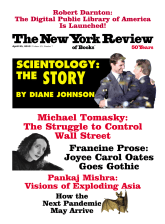In response to:
It's For Your Own Good! from the March 7, 2013 issue
To the Editors:
In his revealing review of Sarah Conly’s Against Autonomy: Justifying Coercive Paternalism [NYR, March 7], Cass Sunstein seems to agree that not all things in life should be available to people in a democratic society simply because they want to have them. But he also overlooks an important element in John Stuart Mill’s On Liberty, which he uses as a foundation for his own libertarian version of paternalism or what he prefers to call “nudges” in another context. While it is true that Mill’s work provided the most important and powerful justification for human freedom, his argument from harm (simplified as “do what you will as long as you harm no one but yourself”) provides the undergirding for Mill’s chapter on thought and opinion.
Sunstein does not address chapter five on “Applications.” There, Mill suggests the limits on human decisions even when those decisions affect only the individual making them. He gives, for example, this prospect: suppose a man wishes to cross a bridge, so why should anyone prevent him from doing so? Under most circumstances, the answer is, of course he may cross. However, Mill continues, “If anyone saw a person attempting to cross a bridge which had been ascertained to be unsafe, and there were no time to warn him of his danger, they might seize him and turn him back without any real infringement of his liberty; for liberty consists in doing what one desires, and he does not desire to fall into the river.”
How would this play out in the very examples that Sunstein (and Conly) give us: Mayor Bloomberg’s policy to outlaw supersized sodas because they are one of many foundations of contemporary American obesity or efforts to ban cigarettes because they cause cancer? Surely the consumers of 16 oz. sodas do not wish to become obese; that cannot be the reason for their desire to drink so much. The same with tobacco: smokers do not smoke with the desire to die of cancer someday. But doesn’t someone, as in Mill’s example of the harm that may accrue to the walker on the bridge, have a duty to just say no?
Jack Fruchtman
Professor of Political Science
Director, Program in Law and American Civilization
Towson University
Towson, Maryland
To the Editors:
Both Sarah Conly and Cass Sunstein, when considering “freedom of choice,” ignore that decisions made by individuals may impose consequences of those choices upon others. Examples are health insurance costs and the consequences of criminal uses of guns. When food choices lead to obesity and diabetes and their consequences, as well as nonlethal gunshot wounds, the costs of health insurance required for the treatments are imposed upon others who are not risk-takers. Where do “freedom” and “responsibility” intersect? Should “freedom” also consider those who chose not to take the risks upon themselves?
David M. Brown, M.D.
Emeritus Dean and Professor
University of Minnesota Medical School
Minneapolis, Minnesota
Cass R. Sunstein replies:
I am grateful to David Brown for emphasizing that when people run risks, they may well end up imposing costs on others. If you fail to take care of yourself and get sick, taxpayers may ultimately have to foot the bill. Brown’s point might be understood to suggest that the state legitimately interferes with certain risky choices, not on paternalistic grounds, but to protect others from harm. No one is an island.
But we have to be careful with this point. In a society that prizes freedom, the government should not use the system of health insurance, with its various subsidies, as a license to establish mandates with respect to acceptable food, diet, and exercise. In any event, many of us do end up paying all or most of the price for our own mistakes. In such cases, harm to others is not involved, and if officials are seeking to protect people from themselves, they must explore the legitimacy of paternalism.
Jack Fruchtman draws attention to Mill’s acknowledgment that if someone is about to cross an unsafe bridge, it is permissible (and perhaps even obligatory) to save his life by seizing him, at least if there is no time to warn him. Fruchtman asks: How can we distinguish this case from those in which the government seeks to regulate smoking and unhealthy eating? This important question has at least two answers.
First, Mill’s framework suggests that when people run risks, a warning is the preferred approach (unless time is an obstacle). For smoking, of course, the US government can and generally does rely on warnings, not on legal prohibitions. Second, Mill uses the bridge example to show that in some cases, paternalistic interventions can promote people’s ends (“he does not desire to fall into the river”) even if they override people’s means.
With respect to eating and smoking, it is not so easy to distinguish between ends and means. One of your ends may be to have as many delicious meals as you can, even if what you find most delicious is also pretty fattening. It is true that tobacco addiction raises serious complications for opponents of paternalism, but even in that case, nudges have significant advantages over bans (which would, among other things, create black markets).
With the bridge example, Mill does offer an important qualification to his own approach. If we think that people lack information about the cumulative effects of their consumption choices, it is possible that Mayor Bloomberg’s relatively modest soda initiative, recently struck down by a lower court and now tied up in litigation, could draw support from that qualification. But in order to justify other, more ambitious measures to limit obesity or smoking, we would have to go well beyond Mill’s bridge example.



